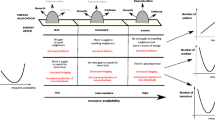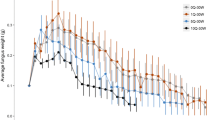Abstract
We formulate a mathematical model for food collection and production of workers and nymphs in 2 species of mound building termites. We maximise the number of nymphs (reproductives) produced by each colony over its lifetime with respect to the proportion of eggs that hatch as nymphs as opposed to workers. The results predict that food storage has a very important influence on the pattern of nymph and worker production. Food storage affects the part of the year that nymph production dominates, whether nymphs and workers are produced at the same time or not, and the existence of a final phase in the colony’s life when a very large number of nymphs but no workers are produced.
Similar content being viewed by others
References
Cohen, W.A., 1933. An analysis of termite (Eutermes exitiosus) mound material. J. Counc. Sci. Ind. Res. 2, 166–169.
Evans, T.A., 2002. Tunnel specificity and forager movements in subterranean termites (Isoptera: Rhinotermitidae and Termitidae). Bull. Entomol. Res. 92, 193–201.
Evans, T.A., Gleeson, P.V., 2001. Seasonal and daily activity patterns of subterranean, wood–eating termite foragers. Aust. J. Zool. 49, 311–321.
Evans, T.A., Lenz, M., Gleeson, P.V., 1998. Testing assumptions of mark-recapture protocols for estimating population size using Australian, mound-building, subterranean termites (Isoptera: Rhinotermitidae and Termitidae). Ecol. Entomol. 23, 139–159.
Fei, H.X., Henderson, G., 2003. Comparative study of incipient colony development in the Formosan subterranean termite, Coptotermes formosanus Shiraki (Isoptera, Rhinotermitidae). Insectes Sociaux 50, 226–233.
Fyfe, R.V., Gay, F.J., 1938. The humidity of the atmosphere and the moisture conditions within mounds of Eutermes exitiosus. Council for Scientific and Industrial Research, Pamphlet No. 82.
Gay, F.J., Greaves, T., 1940. The population of a mound colony of Coptotermes lacteus (Frogg.). J. Counc. Sci. Ind. Res. 13, 140–149.
Gay, F.J., Greaves, T., Holdaway, F.G., Wetherly, A.H., 1955. Standard laboratory colonies of termites for evaluating the resistance of timber, timber preservatives, and other materials to termite attack. Bulletin 277 of C.S.I.R.O., Melbourne, Australia.
Grassé, P.P., 1986. Termitologia, Tome 3: Comportement, socialite, écologie évolution, systématique. Masson, Paris.
Hill, G.F., 1942. Termites (Isoptera) from the Australian Region. C.S.I.R. Publishing, Melbourne.
Holdaway, F.G., 1933. The composition of different regions of mounds of Eutermes exitiosus. J. Counc. Sci. Ind. Res. 6, 160–165.
Holdaway, F.G., Gay, F.J., 1948. Temperature studies of the habitat of Eutermes exitiosus with species reference to the temperatures within the mound. Aust. J. Sci. Res. B—Biol. Ser. 1, 464–493.
Holdaway, F.G., Gay, F.J., Greaves, T., 1935. The termite population of a mound colony of Eutermes exitiosus Hill. J. Counc. Sci. Ind. Res. 8, 42–46.
Lainé, L.V., Wright, D.J., 2003. The life cycle of Reticulitermes spp. (Isoptera : Rhinotermitidae): what do we know? Bull. Entomol. Res. 93, 267–278.
Lee, K.E., Wood, T.G., 1971. Termites and Soils. Academic, London.
Ratcliffe, F.N., Greaves, T., 1940. The subterranean foraging galleries of Coptotermes lacteus (Frogg.). J. Counc. Sci. Ind. Res. 13, 150–160.
Ratcliffe, F.N., Gay, F.J., Greaves, T., 1952. Australian Termites. CSIRO, Melbourne.
Roisin, Y., Lenz, M., 1993. Origin of male-biased sex allocation in orphaned colonies of the termite, Coptotermes lacteus. Behav. Ecol. Soc. 51, 472–479.
Seierstad, A., Sydsaeter, K., 1987. Optimal Control Theory with Economic Applications. Elsevier, Amsterdam.
Thorne, B.L., Breisch, N.L., Traniello, J.F.A., 1997. Incipient colony development in the subterranean termite Reticulitermes flavipes (Isoptera: Rhinotermitidae). Sociobiology 30, 145–159.
Watson, J.A.L., 1972. An old mound of the Spinifex termite Nasutitermes triodiae (Froggatt) (Isoptera: Termitidae). J. Aust. Entomol. Soc. 11, 79–80.
Watson, J.A.L., Abbey, H.M., 1977. The development of reproductives in Nasutitermes exitiosus (Hill) (Isoptera: Termitidae). J. Aust. Entomol. Soc. 16, 161–164.
Watson, J.A.L., Abbey, H.M., 1986. Seasonal cycles in Nasutitermes exitiosus (Hill) (Isoptera: Termitidae) 2. Nest temperature. Sociobiology 11, 255–273.
Watson, J.A.L., Abbey, H.E., 1993. Atlas of Australian Termites. C.S.I.R.O., Canberra.
Watson, J.A.L., Sewell, J.J., 1981. The origin and evolution of caste systems in termites. Sociobiology 6, 101–118.
Watson, J.A.L., Ruyooka, D.B.A., Howick, C.D., 1978. The effect of caste composition on wood consumption in culture of Nasutitermes exitiosus (Hill) (Isoptera: Termitidae). Bull. Entomol. Res. 68, 687–694.
Author information
Authors and Affiliations
Corresponding author
Rights and permissions
About this article
Cite this article
Cameron, D.A., Ivers, D.J., Evans, T.A. et al. Optimal Reproduction Strategies in Two Species of Mound-Building Termites. Bull. Math. Biol. 70, 189–209 (2008). https://doi.org/10.1007/s11538-007-9248-3
Received:
Accepted:
Published:
Issue Date:
DOI: https://doi.org/10.1007/s11538-007-9248-3




